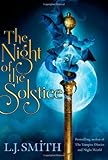
 The Night of the Solstice by L.J. Smith
The Night of the Solstice by L.J. Smith
The Night of the Solstice, followed by its sequel Heart of Valor, were Lisa Jane Smith‘s first novels, targeted at younger readers, unlike her later (and more popular) horror/teen romance novels surrounding the lives of vampires, witches, shapeshifters and the like.
In her delving into the fantasy world, L.J. Smith introduces us to the four siblings, responsible Alys, normal Charles, kooky Janie and dreamy Claudia who have absolutely nothing to do with each other. All that changes however, when a red vixen lures seven year old Claudia to the strange house upon the hill and asks for her help in saving her mistress, the sorceress Morgana Shee. Convincing Claudia to bring her brother and sisters to the house, the vixen soon enlists all three of them to help her in her quest.
She explains that the house is called Fell Andred — the House of Mirrors, and that it serves as a gateway between this world, known as the Stillworld, and the Wildworld. Each mirror within the house leads to the Wildworld, and it is through these mirrors that Morgana’s kidnapper, the twisted and evil sorcerer Cadal Forge, plans to journey through on the Night of the Solstice to exact revenge on the world that once betrayed him.
But when the vixen disappears, the children are left on their own, with only two weeks before the Solstice, to master the mirrors, rescue Morgana and prevent Cadal Forge and his sorcerie from entering their world.
Its seems a magical premise, but often L.J. Smith‘s writing style falls short of the narrative. She is best at human nature: relationships between people, responses to the supernatural, the meeting of challenges — all this she handles with ease. However, in the context of the fantasy world she presents exposition of how the Wildworld runs in large, confusing chunks, (usually through someone talking or reminiscing) instead of a gradual unwinding of figures and facts, and often dwindles on the wrong situations — rather than conveying the potentially fascinating history and information of her world in an interesting manner, she gives us Janie overhearing a catty conversion between two school friends that really lends nothing to the story. This is unfortunately a constant trend in the novel: skipping over what could be the most interesting scenes and giving them to us in hindsight (such as Charles luring Elwyn, the creation of the Heart of Valor, and the trio of children [minus Janie] being confronted by the sorcerei).
The pacing is exhausting — the conflicts and problems flit by in rapid succession, jumping from scene to scene with no respite in between from one crisis to the next. Some may consider constantly moving action a good thing (one is never in need of excitement during the course of the story), but sometimes the pacing needs a little rest: it is in restful moments were we get to know the characters a little better, and let them reflect on their thoughts and circumstances.
Solutions to problems often fall into the children’s heads out of nowhere, or at least from very unlikely drawn conclusions: (Claudia for example identifies an imposter by the size of her feet as compared to barely-glimpsed footprints in the dust, and Charles sudden awareness of how to combat the Groundsler by its scantily-revealed clues seems out of the blue) and for the most part the narrative goes nowhere — the children travel through the mirror, triumph over a certain obstacle and then return, often with little or no progress in their overall quest.
However, despite my criticism, young fantasy fans will enjoy this: it’s exciting, suspenseful and inventive, and L.J. Smith paints vivid pictures of family relations and child perceptions. The comparisons between our sunlit world and the shadowy, night-time Wildworld is delightful, with Morgana’s house as a clever gateway between the two. She is a master at creating interesting names (Elwyn Silverhair and Thia Pendriel, for example) and all her plot threads flow together nicely.
Though she is certainly not up to the standards of Susan Cooper and E. Nesbit, L.J. Smith‘s first novel is a strong, colourful and compelling, and leaves room for a sequel — make sure you have a copy of Heart of Valor on hand after finishing this one.





Me, too! I think independent bookstore are enjoying a golden age, and I plan to continue to support that. One…
I read the most recent Elysian article. I tried not be bummed out, because I already knew most of it,…
Wow, I'm really impressed by the 15- and 20-year old owning and running their own bookstores! I loved books as…
There were two interesting articles about publishing that I ran across, the first via a link in the second: No…
My pleasure, Robin! And yes, it surely is some kind of an experience, to be sure....